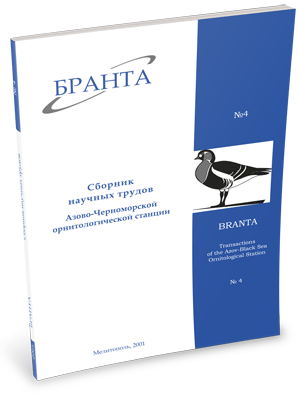
Transactions
of the Azov-Black Sea Ornithological Station



Ornithofauna of the Regional Landscape Park “Izmailskie islands”.
Potapov O.V.
The RegionalLandscapePark "Izmailskie islands ” (RLP) was founded in 1996 on the territory of three islands in the inner delta of the Kiliysky tributary of the Danube within lzmailsky district of Odessa region (fig.). RLP includes Maly Tataru (45°21'N,29°OO'E), Maly Daller (45°22'N,26°06'E) and Bolshoy Daller islands (45°23'N,29°06’E ). Total area of the park islands is about 1300 ha (M. Tataru - 738, M.Daller - 258 and B.Daller - 370 ha).
Origin of RLP islands is alluvial. Relief is formed by water-course bank, where the bottomland forest grows (Salix alba, Populus alba, P. nigra Ulmus laevis, Fraxinus lanceolata, Querqus robur) together with meadow vegetation. Among undergrowth Rubus caesius is distributed. There are also Vitis sylvestris and Periploca graeca in the bottomland forest. Central parts of the islands are lower and watered (plavni). Open water areas in the islands are different in their size.
Systematic investigations of birds on the islands were carried out from July 1997 to August 2000 together with census on routes and sites. Colonial settlements were mapped. Absolute (for colonial bird species) and estimated bird counts was carried out on routes and control plots (for the majority of wood birds and single breeding birds of wetland complex). There were a total of 176 census days on RLP islands. For the period of investigation 161 bird species were recorded by us on the RLP territory. 93 of them breed on islands or in surrounding areas.
176 bird species breeds in the Danube delta (Radu, 1979). Island ornithocomplexes are poorer in their composition. For the period of our investigation on islands there was recorded a reliable breeding of 60 bird species. Representatives of 13 species bred in the surrounding areas and regularly visited the islands in breeding period. Brief reviews for 49 bird species are given below. These are species on which we have more complete information. Dynamics of colonial species is shown in Table 1, general composition of fauna and status of some species are presented in Table 2.
On a total area of 1300 ha there was recorded half of all regional ornithofauna. There were registered 21 species included in the Red Data Book, 4 of them (Pelecanus crispus, Rufibrenta ruficollis, Aythya nyroca, Aquila clanga) are globally threatened in Europe and one of them (Aythya nyroca) is breeding on the islands.
The central parts of plavni have the richest species diversity. Phalacrocorax carbo and Phalacrocorax pygmeus, Nycticorax nycticorax, Ardea cinerea, Ardea purpurea, Egretta alba, Egretta garzetta and Ardeola ralloides, Larus ridibundus and Larus cachinnans, Chlidonias hybrida regularly breed there. Platalea leucorodia and Plegadis falcinellus do not breed regularly. 60% of total numbers were distributed on Great Daler, 29% on Maly Daler. Plavni of the islands of Maly Daler and Maly Tatary are the principal habitats of gulls breeding sites. Colonies of two species of Cormorant and Egretts are mostly concentrated on the island of Big Daller.
Parts of bottomland forest are important breeding places (Haliaeetus albicilla, Columba palumbus, Driocopus martius, Picus canus, Dendrocopus major Phoenicurus phoenicurus, Luscinia luscinia, Parus major, Parus caeruleus,etc.).
In the central parts of the islands are the stopovers of migratory and summering (staying for the summer) waterbirds Phalacrocorax pygmeus (up to 1500 individuals); Phalacrocorax carbo (up to 3000 individuals); Pelecanus onocrotalus (up to 1300 individuals); Ciconia nigra (10-15 individuals); Anser anser (up to 2200 individuals); Aythya ferina (up to 1200 individuals); Aythya fuligula (up to 800 individuals); Aythya nyroca (up to 200 individuals); Pandion haliaetus (single individuals); Chlidonias hybrida (up to 1500 individuals); Hydroprogne caspia (single individuals).
Read the paper in a PDF file